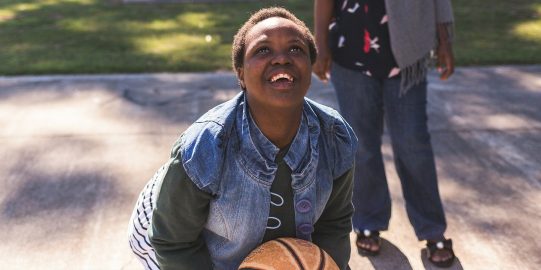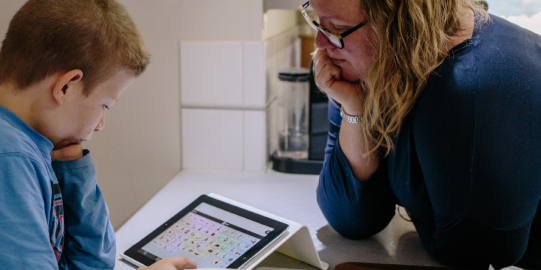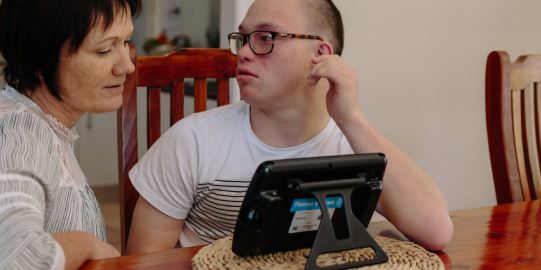This article describes simple tools and strategies to support every person to understand, compare and express their preferences as they make decisions. These strategies apply even if they are still learning to use words or Augmentative and Alternative Communication (AAC) to fully express themselves.
What does supported decision-making include?
In ‘Real choices, real control: support for decision-making when you cannot speak’ we explain the process of supported decision-making. It aims to help AAC users to discover and share:
- Who they are as an individual and what makes them unique;
- What is important to them, what is not negotiable and what they prioritize in their life above all else;
- Who they want help from to make decisions;
- What communication partners need to know about how the person communicates so that they can respond in a way that is respectful and acted upon;
- What support is needed so they fully understand the information and choices given to them;
- What decisions they can make for themselves, and which decisions they need support with;
- When they need this support, e.g. regularly and daily, or occasional?
Three steps
Supported decision-making focuses on giving a person more autonomy, i.e. choice and control. It can be divided into three steps: expressing preferences, prioritizing them, and taking action.
Step 1: Expressing preferences
Discovery
Supported decision-making starts with discovering how the person expresses what they like, don’t like, and what is most important to them. This ensures the person is heard when they express preferences, positive or negative: I like this, I don’t like that. Every person expresses preferences, but sometimes very subtly. The more subtle and unique a person is in their communication, the more likely it is that others will make decisions for them instead of with them.
Some people may not yet express preferences using words or AAC, but in other ways:
- sounds and vocalizations, like a happy squeal for joy or a groan for discomfort
- gestures, such as reaching for what they want or pushing away what they don’t
- facial expressions, such as a smile or grimace
- body movements, such as turning towards/away from what interests/disinterests them, or walking away from an unpleasant environment.
How to increase expressions of preference
- Maximize opportunities for the person to express preference across the day. Set goals that the person will express preferences (likes and dislikes) more times across the day. Ask the person to reflect on their different activities and experiences, indicating LIKE or NOT LIKE. Carefully observe the person in these activities: what were they expressing?
- Support the person to become more transparent and consistent in how they express preferences. Use the person’s AAC to describe how you interpreted their actions. Model what words they could use to express their preferences. “You laughed during the show, I think you LIKED it.”
- Keep a chart or log on what the person responded to so that it can be used to develop a more detailed profile of preferences.
- Support more communication partners to interpret this behavior as an expression of preference. Tools include communication passports, gesture dictionaries, and communication charts.
- Model the person’s AAC to reflect what they are expressing: “I see your smile and I hear your laugh. I think you LIKE this. I THINK you LIKE this a LOT!”
- Introduce a ranking scale. Model the use of a ranking scale when talking about preferred and non-preferred activities. Provide visuals to help the person indicate MOST and LEAST. A simple “thumbs up/thumbs down”, or ranking 1, 2, or 3 stars, can help set priorities and clarify preferences.
- Maximize opportunities to express preference and rank the options. The person with communication disabilities can be encouraged to regularly reflect on each part of their day. Ask them what they thought of different activities: if they LIKED it or NOT and what they liked MOST and LEAST.
- Build the infrastructure that allows this person to understand, compare, and express choices. Create a framework, chart or other aid to support the decision-making and to document the choices.
Sara expresses preferences
During the school holiday concert, Sara fussed and covered her ears. Her support staff used Sara’s AAC to model “I think you DO NOT LIKE this, it is too LOUD” on her AAC. Sara vocalized, which her aide interpreted as agreement. The aide then offered Sara the choice to STAY at the concert or GO to the library. The aide indicated both “STAY” and “GO” on Sara’s AAC, then waited for Sara to respond. Sara smiled and got up to leave the concert. The aide modeled, “You have decided to GO” as they left for the library. The aide noticed a trend that Sara was becoming more expressive about how she feels in noisy locations.
Step 2: Prioritizing
Ranking preferences
It is crucial that we support the ability to rank preferences: expressing concepts such as MOST and LEAST, or FAVOURITE. Ranking activities allow people to compare one decision against another. It helps involve the person in choice-making and establish priorities.
Strategies that support ranking preferences include:
- Model the person’s AAC to reflect what they are expressing: “I see your smile and I hear your laugh. I think you LIKE this. I THINK you LIKE this a LOT!”
- Introduce a ranking scale. Model the use of a ranking scale when talking about preferred and non-preferred activities. Provide visuals to help the person indicate MOST and LEAST. A simple “thumbs up/thumbs down”, or ranking 1, 2, or 3 stars, can help set priorities and clarify preferences.
- Maximize opportunities to express preference and rank the options. The person with communication disabilities can be encouraged to regularly reflect on each part of their day. Ask them what they thought of different activities: if they LIKED it or NOT and what they liked MOST and LEAST.
- Build the infrastructure that allows this person to understand, compare, and express choices. Create a framework, chart or other aid to support the decision-making and to document the choices.
Anna rank orders what is important to her
Anna was faced with the decision of where to live after her stroke. She had always assumed she would age in her own home. However, after her stroke, she could no longer drive. She was frustrated living far away from friends and the activities she most enjoyed. Anna’s speech therapist helped Anna and her loved ones use a prioritizing procedure. The goal was to identify what is important to Anna, which is somewhat important, and what is not important.
Supporting comprehension
Anna was provided with line drawings that represented everything from eating and cooking to noise levels and personal care. She indicated which specific items were very important to her, or were somewhat important to her, or were not important to her at all. Anna found that the visuals helped her retain her focus on the idea and helped her rank items more easily.
This process helped Anna's family decide that Anna was likely looking for a quiet assisted living facility where paid staff could provide care and meals, and where Anna could join in a range of activities with other seniors.
Step 3: Taking action
Create a framework
The final essential step of supported decision-making is to turn preferences into actions. One tool is to document them in a decision-making agreement: this is simply a framework that explains how the person will be involved in decisions about their life. In Anna’s case above, deciding where she would live was a shared decision. The decision-making agreement illustrated how Anna would participate and what support she needed. Below, the example of Samuel shows how he uses his decision-making agreement to develop his personal support plan. This plan will ensure that the staff person who supports Samuel in school will respect the decisions that Samuel will make for himself.
Samuel takes action
Samuel is preparing for life after school. Like many of his classmates, Samuel hopes to attend college. He is excited for a traditional student experience. He wants to live in a dorm and attend classes with friends. Samuel knows he will need support with daily living. He wants his college support person to be more like a peer or employee than the educational assistant who supported him in high school. It is important to Samuel that the future support person does not infringe on Samuel’s right to experience daily college life. Together with his school transition team, Samuel prepares a daily support plan and decision-making agreement. His support person will help him get dressed and bathed each day, but Samuel will select his own clothes and the foods he will eat. His support person or a peer will accompany him to class and ensure his AAC is in reach, but Samuel will decide when, where, and how he communicates with it. He is very clear: he does not want to be prompted to use his device. That decision is now his alone. Samuel’s transition team even goes so far as to write the job description and hiring announcement for Samuel’s future support person. These documents make it clear: Samuel’s staff must respect the boundaries between supporting Samuel and directing him.
Links and references:
- Auckland Disability Law, Supported Decision-Making in Action (PDF), New Zealand
- CALL Scotland. Create personal communication passports and Passports book. [Resources & templates]
- Funk & Drew (2017). Realizing supported decision-making and advance planning: pilot training for people with disabilities, their supporters, and service providers. World Health Organization.
- Helen Sanderson & Associates. Communication Charts. Includes a simple PDF template to make your own chart.
- James & Watts, (2014). UNDERSTANDING THE LIVED EXPERIENCES OF SUPPORTED DECISION-MAKING IN CANADA: Legal Capacity, Decision-Making and Guardianship (PDF), Law Review of Canada.
- Sinclair, Field, Williams, Blake, Bucks, Auret, Clayton, & Currie (2018) Supported Decision-Making for People with Dementia (PDF), a manual that is relevant to any disability group.
- Zangari, C. (2018). On the Same Page: Helping Team Members Recognize and Respond to Unconventional Communication Signals. [Blog post that includes a template to create "How I Communicate" Books].





